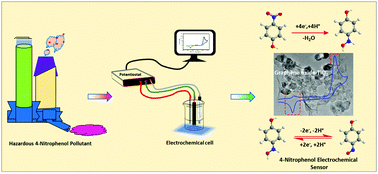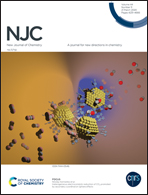Enhanced sensing of hazardous 4-nitrophenol by a graphene oxide–TiO2 composite: environmental pollutant monitoring applications†
Abstract
The accurate detection of hazardous 4-nitrophenol (4-NP) is deemed essential for the environment and human health. Exploring efficient and low-cost methods for its monitoring has become completely necessary in the current century. Herein, the high-level sensing behavior of a graphene oxide–TiO2 composite for the detection of hazardous 4-NP, using a simple electrochemical sensor technique, is reported. The hybrid electrocatalyst of graphene oxide–TiO2 composite material was prepared via an ultrasound assisted sonication method. The structural and physiochemical properties were determined in detail using PXRD, TEM, HR-TEM, Raman, FTIR, XPS, UV-DRS and BET isotherm studies. The graphene oxide–TiO2 composite shows superior electrocatalytic performance for the detection of 4-NP with high sensitivity (3.9831 μA μM−1 cm−1) coupled with a low limit of detection (LOD) and limit of quantification (LOQ), which were found to be 0.0039 μM and 0.0131 μM, respectively. This study offers an excellent platform for exploring graphene oxide–TiO2 composite materials with great potential for monitoring hazardous environmental pollutants.



 Please wait while we load your content...
Please wait while we load your content...